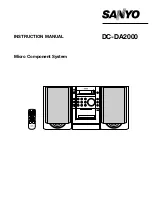
EM 100 G2, EM 300 G2, EM 500 G2
9
08/2004
3.2.1 RF module shielded compartments
The shielded compartments on the RF module perform the following functions:
•
The two compartments between the BNC sockets contain the second mixer,
the 10.7MHz limiting amplifier and the FM demodulator.
•
The compartment directly behind the BNC socket contains RF conditioning
up to an including the SAW filter for the first IF.
•
The middle compartment performs frequency conditioning for the first
oscillator with VCO, buffer and PLL for both diversity channels.
The input filters are assembled outside the shielded compartments to ensure that
parasitic LO frequency currents cannot be coupled directly to the RF input. The in-
put filters are relatively complex owing to the integrated IF and LO cases,
but nevertheless do not require alignment.
3.2.2 Alignment of the RF module
The only components still to be adjusted are
•
C540 for alignment of VCO voltage at center frequency,
•
C330 for setting the LO2 crystal oscillator,
•
The L310 and L410 discriminator coils, and
•
The two level adjusters for the AF outputs.
For communication with the processor on the mainboard, the RF module contains
the U700 EEPROM, in which the relevant frequency range data, the RSSI table and
other status data are stored. Communication is processed via the same bus used by
the microprocessor to communicate with the PLL U500 (frequency setting).
3.3
Display module
The display module for the status displays is connected to the mainboard via a
15-pin ribbon connection.
3.4
Monitor module (only EM 500 G2)
The monitor module (MOD.A020) is a single-sided PCB assembly and is connected
to the mainboard via a 15-pin plug-in connector. The monitor module PCB has a jack
socket for connecting headphones, and an appropriate volume control. The monitor
module also has a complete U1 and U2 amplifier for each AF phase; the volume can
be adjusted via R1.
The monitor module is primarily intended for stereo operation, but in phase confi-
guration is possible for mono operation. If you want to minimize the volume diffe-
rences in mono operation between the left and right channel (this may occur as a
result of the tolerances of R1), you must close the M1 solder bridge.
You must not close the M1 solder bridge if you are using the monitor
module in stereo mode.










































